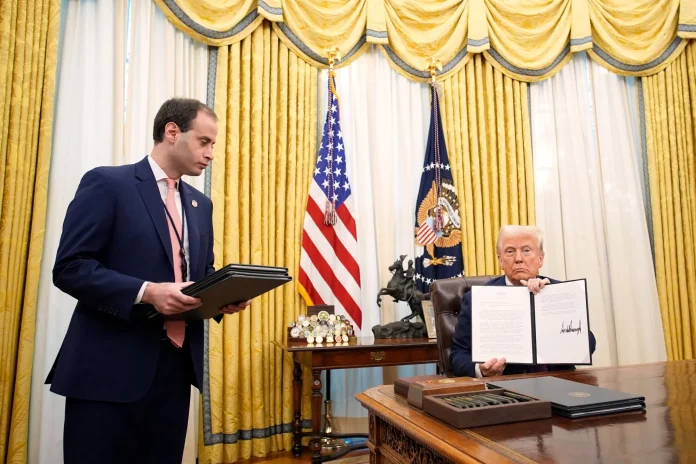The United States witnessed a critical policy change when Donald Trump through executive order banned the entire process of Central Bank Digital Currency (CBDC) development in the nation. His administration takes steps to back private cryptocurrency sector development while establishing decentralized financial systems as a strategy. The Order blocks the creation of CBDCs while it updates regulatory guidelines along with establishing plans to maintain a nationwide Bitcoin reserve. This decree reshapes the digital financial environment by establishing a prospective framework which will impact both U.S. and global markets.
The Ban on CBDCs: Safeguarding Decentralization
An essential element of Trump’s executive order prohibits all institutions from developing or distributing CBDCs. Central bank-issued digital assets which proponents believe will transform financial operations are known as CBDCs. During Trump’s Administration, the administration pursued an opposing approach regarding CBDCs because officials raised privacy issues together with centralized control challenges and concerns about loss of financial independence.
Under the order’s provision,s agencies must refrain from pursuing CBDC establishment or promotion unless a federal law authorizes their actions. This order signals all CBDC-related programs must be frozen immediately. Trump positions CBDCs as central government systems running against free-market economy principles representing both centralized control and assault against privacy. The current administration has chosen to support dollar-backed stablecoins through private management channels instead of CBDCs because these currencies stay separate from federal oversight power.
The U.S. adopts a distinct position against central bank digital currencies as China continues advancing with its digital yuan program. Through this decision, Trump demonstrates his commitment to government intervention reduction while promoting market-driven financial sector innovation.
Also read: President Donald Trump’s Executive Orders: Birthright Citizenship & Policies
Promoting Private-Sector Crypto Innovation
Strong support for private-sector-driven digital asset networks exists within Trump’s executive order. The policy highlights the strategic importance of stablecoins as substitute money systems instead of CBDCs. The assets serve as decentralized transaction tools which maintain the USD’s worldwide position as the dominant currency while being supported by old fiat money systems.
The executive order instructs federal agencies to establish protections for crypto companies that wish to access banking services. Previous regulatory approaches diverged significantly from this new policy because they systematically examined cryptocurrency firms to fight counterfeiting and money laundering. The directive from Trump advocates for crypto businesses to reach their banking needs fairly while creating conditions suitable for industrial growth.
The industry in the cryptocurrency space supports this new approach wholeheartedly. The new policy diverges significantly from former Biden-era enforcement tactics which led to litigation against Coinbase and Binance for US regulatory infractions. Trump’s administration believes basic regulatory directions will elevate the United States to global leadership among digital asset programs.
The Strategic Bitcoin Reserve: A Bold Vision
The executive order’s most ambitious element suggests establishing a national Bitcoin reserve. The Bitcoin assets seized by law enforcement agencies throughout the United States will fund this strategic reserve. The United States government presently controls 198,000 Bitcoins worth approximately $20 billion. Under Trump’s proposal, the United States would use seized digital assets to create reserve holdings that would boost its position as the world leader in digital currency markets.
The administration plans to use seized Bitcoin assets along with additional Bitcoin purchases to build a national Bitcoin reserve. The proposed legislation could lead to yearly Bitcoin purchases amounting to 200,000 during the next five decades. With this project in place, the United States would gain control of more than 1 million Bitcoins which would boost its authority across worldwide cryptocurrency domains.
Regulatory Frameworks for Digital Assets
Through a presidential assignment group, the executive order enacts a multiteam initiative to establish digitally regulated asset frameworks. The working group responsible for building a regulatory framework consists of the Treasury Secretary alongside the heads of the SEC and CFTC it will focus on essential matters spanning market structure to consumer protection to risk management.
In addition to its existing duty, the working group needs to examine whether establishing a national digital asset stockpile is operable. Trump uses this planning strategy to establish America’s position as a leader in cryptocurrency sector development.
Under this order, some accounting regulations which blocked cryptocurrency adoption have been formally discontinued. The order eliminates costly requirements that companies face when they keep digital assets for third-party account holders. The modified rules aim to create simpler entry points for companies while promoting widespread market adoption of blockchain solutions.
Global Implications of the Executive Order
The worldwide financial structure faces important consequences due to Trump’s initiative to prohibit CBDCs while advancing private sector market creations. The United States differentiates itself from other nations because it opposes centralized digital currency programs that other governments use for economic progress. The governments of China Brazil plus South Korea have focused their efforts on CBDCs because they recognise these digital assets will help them gain better monetary control and enhance operational speed.
Trump’s administration opts to uphold the dollar’s paramount status through decentralised financial platforms known as stablecoins. The deployment strategy between nations regarding digital currencies can establish mutual competition between countries supporting divergent policies for digital money systems. Through this approach, the country establishes itself as a leader of economic liberty combined with market-led economic advancement.
A new approach by the administration brings various difficulties alongside its strategic changes. The United States may lose its position as a leader in digital finance innovations because it lacks a CBDC according to its opposing critics.
A Turning Point for Cryptocurrencies
The cryptocurrency community welcomes Trump’s executive order as the industry’s first major breakthrough. Through regulatory cooperation and decentralised policies mentioned in the order, digital assets can gain broader societal acceptance. The cryptocurrency market experienced significant growth including Bitcoin which reached new all-time value records because investors grew optimistic and increased their interest.
The administration directs its attention toward Bitcoin and other cryptocurrency assets because they demonstrate promising indications of becoming legitimate assets within standard finance systems. Long-term success in this scenario demands a perfect equilibrium between governmental oversight and the essential principles of decentralisation.
Conclusion
Trump’s executive order introduces a core transition point in digital economic development. The United States is working to establish its new position in the international cryptocurrency market through private sector-leaning Bitcoin policy reforms and inconsistent support for centralised digital money systems. With strategic Bitcoin reserves and supportive regulations, the United States will become a leader among global digital financial technology providers.
People across the world will monitor legal amendments to understand their influence on cryptocurrency futures. Whether they lead to greater innovation and adoption or create new challenges, one thing is certain: Trump’s policies established fundamental principles which are propelling the digital financial sector into a new era.








